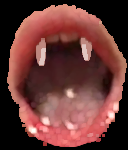Joanne Rowling
Vampires do not appear as major characters in J. K. Rowling's Harry Potter books, but it is clear they exist, and there are many mentions of them in the books. They show many of the stereotypical characteristics of vampires in other milieus. They are clearly Dark Magic creatures, though they are sometimes tolerated in social settings.
Harry Potter and the Philosopher's Stone
In chapter 8, Professor Quirrell says that he met a vampire in Romania, and the large quantities of garlic in his classroom are attributed to his fear that it is tracking him. Whether or not this is true, it is accepted as plausible by other characters, so we can assume vampires are repelled by garlic.
In chapter 15, Voldemort drinks unicorn blood, but this appears unrelated to vampirism: it is the special properties as the blood of a magical creature that make it attractive to Voldemort, not the fact that it is blood.
Harry Potter and the Chamber of Secrets
Gilderoy Lockhard is the author of the book "Voyages with Vampires", mentioned in chapter 4 as a school textbook. In chapter 6, Hermione is seen reading the book, and in chapter 10, Professor Lockhart talks of dealing with a vampire who now, "only eats lettuce", probably another reference to the events described in his book.
Harry Potter and the Prisoner of Azkaban
In chapter 3, Harry thinks that Sirius Black, in a photograph in the Daily Prophet, looks like a vampire, particularly noting his waxy white skin.
In chapter 10, Harry, Ron and Hermione find blood-flavoured lollipops in Honeydukes, the Hogsmeade sweet shop, in a section labelled, "Unusual Tastes". Hermione thinks they are for vampires.
In chapter 14, Harry and Neville discuss an essay on vampires they need to write for their Defence Against the Dark Arts class. Neville, it seems, is confused, he asks Harry whether vampires have to eat garlic. Professor Lupin later mentions the same essay. This confirms that vampires are generally regarded as Dark creatures.
At the end of the book (chapter 25), having lost yet another Defence Against the Dark Arts teacher, Dean Thomas speculates that they might get a vampire as the new holder of the post.
Harry Potter and the Goblet of Fire
In chapter 9, a young wizard boasts to a group of Veela that he is a vampire hunter who has killed about ninety vampires. This appears to be an unlikely boast, brought on by the effect of Veela on males, but indicates that hunting and killing vampires could be considered a heroic occupation.
In chapter 10, Percy refers to an article by Reeta Skeeter, which apparently wants the Ministry of Magic to take action and stamp out vampires. Percy objects to this course, on the grounds it is forbidden in paragraph 12 of the Guidelines for the Treatment of Non-Wizard Part Humans. From this, it is clear that vampires are not wizards and regarded as part human.
Harry Potter and the Order of the Phoenix
In chapter 20, Hagrid reports on his trip across Europe with Madam Maxime, saying that he had a slight disagreement with a vampire in a pub in Minsk. Given Hagrid's normally tolerant and affable disposition, and his size and strength, it seems likely the "slight disagreement" was a spectacular fight. It would take serious provocation to rouse Hagrid, and, once roused, he is a formidable foe. Minsk is the capital of Belarus, a former Soviet Republic to the East of Poland, and far to the North of Romania and the traditional haunts of vampires such as Dracula.
When Harry is taking his History of Magic OWL exam in chapter 31, he desperately tries to remember details of the 1749 breach of the Statue of Secrecy, and suspects that vampires were involved. In the real world in 1749, the French naturalist Buffon published his Natural History, in which he described vampire bats and quoted the testimony of travelers and naturalists, as well as his own experience, implying that these bats suck the blood of humans. It is not clear whether Rowling was alluding to this book.
Harry Potter and the Half-Blood Prince
In Chapter 15, while discussing Professor Slughorn's Christmas Party, Luna Lovegood claims that Scrimgeour, the Minister for Magic is a vampire, and says her father wrote a long article proving it in his magazine, the Quibbler. Harry, who has met the Minister, disbelieves this, and it seems unlikely, especially as Scrimgeour is reported to have died at the hands of Death Eaters in the last book.
Later in the same chapter, Harry finally meets a vampire, Sanguini, at Professor Slughorn's Chrismas Party, in the company of Elred Worple, author of the book, "Blood Brothers: My Life Amongst the Vampires". The name Sanguini is obviously derrived from the Latin sanguineus "of blood," also "bloody, bloodthirsty". Sanguini is described as tall and emaciated, with dark shadows under his eyes. A group of teenage witches appear to have a charismatic attraction to Sanguini, who looks at them hungrily. Worple, however, is able to control the behaviour of his companion. The incident gives some clues about the status of vampires in magical Britain: they are not often encountered but are tolerated at social events, not being considered too dangerous to invite to a party including school children. We can infer they are at least, of moderately high status since Slughorn has invited Worple and his friend, and makes a point of introducing Harry - Slughorn is the master networker, cultivating friendships with high-flyers, one cannot imagine him being on such good terms with the author of, say, "My Life Amongst the Sewage-Workers".
Harry Potter and the Deathly Hallows
Vampires are not mentioned in the last Harry Potter book. However, the power of blood is critical to the plot resolution.
